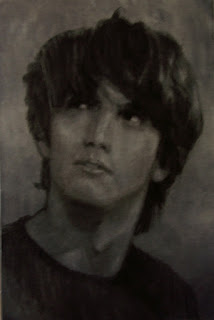But over time I found that these shapes crept into my work, especially in the beginning stages before I started creating the mid-tone shadows for softness. I discovered that using grays (as in a grisaille painting or a charcoal sketch) seemed to free up my process...when I wasn't concerned with color I seemed to instinctively block in the planes in much broader strokes.
Here's a piece I did in 2006 of my nephew. It was just meant to be an underdrawing of charcoal but I so liked the drama of the contrasts that I kept it as is (with tons of fixative to hold the powdery charcoal in place).

The piece was 2 x 3 foot, drawn on a toned canvas. I mainly used the side of the charcoal and just marked the angle lines of the features to keep things lined up. But I did not draw lines at all...mostly because I just wanted to grab the main lights and shadows quickly. There's a bit of freedom in knowing that paint is going over an underdrawing, things can be adjusted later on, and working large is also much more conductive to blocking in shapes, especially if you step back from the easel to take in the overall effect. Negative spaces are equally important as they frame the subject.
I never once consciously thought of cones or circles, I thought of blocks...a block of heavy shadow right here, negative space just there, for the light, but when I stepped back I could see partial elipses, triangles and cones making up the form. Looking back now I see a strength in the shapes, sort of like hewn stone rather than a drawing.
I've heard a lot that using over large brushes in the beginning of a painting has the same effect. If one were wanting to try this but was afraid of messing up, then they could try to dilute the paint for the beginning stages, it's thin and can be built upon (though not too thin or it will lift later on). Or do like I did and drop it in with charcoal. With a good fixative (I actually used retouch varnish) then it can completely be painted over.









